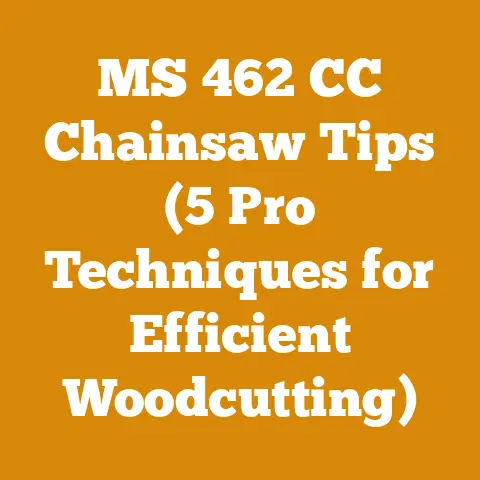Build Picnic Table Profits (Woodworking Hacks to Boost Sales)
I’m going to let you in on a secret: crafting picnic tables isn’t just a hobby; it can be a lucrative venture. I’ve spent years immersed in the world of wood, from felling towering trees to meticulously crafting furniture. I’ve learned firsthand how to transform raw timber into beautiful, functional pieces that people cherish. In this guide, I’ll share my knowledge and experiences to help you navigate the path to building picnic table profits, covering everything from selecting the right wood to mastering essential woodworking techniques.
The Picnic Table Market: A Landscape of Opportunity
Before we dive into the nitty-gritty of woodworking, let’s take a moment to appreciate the potential of the picnic table market. The global outdoor furniture market, which includes picnic tables, is projected to reach \$25.4 billion by 2027, according to a report by Global Industry Analysts Inc. This growth is driven by increasing consumer interest in outdoor living, home improvement projects, and sustainable products.
Specifically, the demand for handcrafted, high-quality picnic tables is on the rise. People are increasingly seeking unique, durable pieces that reflect their personal style and values. This trend presents a golden opportunity for woodworkers like us to create and sell picnic tables that stand out from the mass-produced alternatives.
Understanding Wood: The Heart of Your Craft
Wood is the soul of any woodworking project, and choosing the right species is crucial for the success of your picnic table venture.
Green Wood vs. Seasoned Wood: A Tale of Two Timbers
Green wood, freshly cut from a tree, is full of moisture. It’s easier to work with initially, but as it dries, it shrinks, warps, and can develop cracks. Seasoned wood, on the other hand, has been dried to a stable moisture content. It’s more difficult to work with, but it’s far less likely to warp or crack after being incorporated into your project.
The moisture content of wood is usually expressed as a percentage. Green wood can have a moisture content of 30% or higher, while seasoned wood typically has a moisture content of 6-12% for indoor use and 12-18% for outdoor use.
I once made the mistake of using green wood for a picnic table project. The table looked great at first, but within a few weeks, the boards started to warp and split. It was a costly lesson that taught me the importance of using properly seasoned wood.
Wood Species: Choosing the Right Material for the Job
Different wood species have different properties, making them suitable for different applications. Here are some popular choices for picnic tables:
- Cedar: Known for its natural resistance to rot and insects, cedar is an excellent choice for outdoor furniture. It’s relatively lightweight, easy to work with, and has a beautiful reddish-brown color. However, it’s also one of the softer woods and can dent easily.
- Redwood: Similar to cedar, redwood is naturally resistant to decay and insects. It’s also known for its rich color and durability. Redwood is a more expensive option, but it can last for decades with proper care.
- Pressure-Treated Pine: This is a budget-friendly option that’s been chemically treated to resist rot and insects. Pressure-treated pine is strong and durable, but it can be less visually appealing than cedar or redwood. It’s also important to note that the chemicals used to treat the wood can be harmful, so always wear appropriate safety gear when working with it.
- Oak: A hardwood known for its strength and durability, oak is a good choice for picnic tables that will see heavy use. It’s more difficult to work with than cedar or redwood, but it will stand up to the elements.
- Cypress: Another naturally rot-resistant wood, cypress is a good alternative to cedar and redwood. It’s known for its stability and resistance to warping.
Cost Considerations for Wood Selection
The cost of wood varies depending on the species, grade, and location. As of late 2024, prices fluctuate significantly, but here’s a general idea:
- Cedar: \$4-\$8 per board foot
- Redwood: \$6-\$12 per board foot
- Pressure-Treated Pine: \$2-\$4 per board foot
- Oak: \$5-\$10 per board foot
- Cypress: \$4-\$8 per board foot
When selecting wood, consider the overall cost of the project, the desired aesthetic, and the expected lifespan of the picnic table.
Tools of the Trade: Equipping Your Workshop
Having the right tools is essential for efficient and accurate woodworking. Here’s a list of essential tools for building picnic tables:
Chainsaw vs. Axe: The Timber Felling Debate
If you plan on harvesting your own lumber, you’ll need to decide whether to use a chainsaw or an axe. While an axe is a traditional tool that requires no fuel or electricity, a chainsaw is far more efficient for felling trees.
- Chainsaw: A powerful tool for felling trees, bucking logs, and ripping lumber. Choose a chainsaw with a bar length appropriate for the size of the trees you’ll be felling. Safety is paramount when using a chainsaw. Always wear appropriate safety gear, including a helmet, eye protection, hearing protection, and chainsaw chaps.
- Axe: A traditional tool for felling trees and splitting wood. An axe requires more physical effort than a chainsaw, but it’s a good option for smaller trees and for splitting firewood.
I remember the first time I tried to fell a tree with an axe. It took me hours, and I was exhausted by the end of it. I quickly realized that a chainsaw was the way to go for larger projects.
Essential Woodworking Tools
- Circular Saw: For cutting boards to length and ripping lumber.
- Miter Saw: For making accurate angled cuts.
- Table Saw: For ripping lumber and cutting dados and grooves.
- Drill/Driver: For drilling holes and driving screws.
- Hand Plane: For smoothing and shaping wood.
- Chisels: For fine-tuning joints and removing small amounts of wood.
- Measuring Tools: Including a tape measure, square, and level.
- Clamps: For holding pieces together while gluing.
- Safety Gear: Including safety glasses, hearing protection, and a dust mask.
Advanced Tools (Optional)
- Jointer: For creating perfectly flat surfaces on lumber.
- Planer: For reducing the thickness of lumber and creating smooth surfaces.
- Mortise and Tenon Machine: For creating strong and precise joints.
Cost Considerations for Tool Acquisition
The cost of woodworking tools can vary widely depending on the brand, quality, and features. Here’s a rough estimate of the cost of essential tools:
- Chainsaw: \$200-\$1000
- Circular Saw: \$50-\$200
- Miter Saw: \$100-\$500
- Table Saw: \$200-\$1000
- Drill/Driver: \$50-\$200
- Hand Plane: \$50-\$200
- Chisels: \$50-\$200
- Measuring Tools: \$20-\$50
- Clamps: \$5-\$20 each
- Safety Gear: \$50-\$100
Consider buying used tools to save money, but make sure they are in good working condition.
Designing Your Picnic Table: Form and Function
Before you start cutting wood, it’s important to have a clear design in mind. Consider the following factors:
- Size: How many people do you want the table to accommodate? A standard picnic table is 6-8 feet long and can seat 6-8 people.
- Style: Do you want a traditional picnic table, or something more modern? There are many different styles of picnic tables to choose from, so do some research and find one that you like.
- Materials: What type of wood will you use? Consider the cost, durability, and aesthetic of different wood species.
- Joinery: How will you join the pieces together? Common joinery methods for picnic tables include screws, bolts, and mortise and tenon joints.
- Finish: What type of finish will you apply to the table? A good finish will protect the wood from the elements and enhance its natural beauty.
Picnic Table Design Examples
- Traditional Picnic Table: A simple design with a rectangular tabletop and two benches attached to the legs.
- A-Frame Picnic Table: A more modern design with a triangular frame that supports the tabletop and benches.
- Convertible Picnic Table: A versatile design that can be converted from a picnic table to a bench.
- Wheelchair-Accessible Picnic Table: A design that allows wheelchair users to easily access the table.
Creating a Detailed Plan
Once you’ve decided on a design, create a detailed plan that includes the following:
- Dimensions: Accurate measurements of all the pieces.
- Cut List: A list of all the pieces you’ll need to cut, including their dimensions and the type of wood to use.
- Assembly Instructions: Step-by-step instructions on how to assemble the table.
- Material List: A list of all the materials you’ll need, including wood, screws, bolts, and finish.
A well-prepared plan will save you time and frustration during the building process.
The Art of Woodworking: Building Your Picnic Table
Now that you have a plan and the necessary tools, it’s time to start building your picnic table.
Step-by-Step Guide to Building a Traditional Picnic Table
- Cut the Wood: Using your cut list as a guide, cut all the pieces to the correct dimensions. Use a circular saw or miter saw for straight cuts and a jigsaw for curved cuts.
- Assemble the Legs: Assemble the legs using screws or bolts. Make sure the legs are square and level.
- Attach the Benches: Attach the benches to the legs using screws or bolts. Make sure the benches are level and evenly spaced.
- Attach the Tabletop: Attach the tabletop to the legs using screws or bolts. Make sure the tabletop is level and centered on the legs.
- Sand the Table: Sand the entire table to remove any rough edges or splinters. Start with a coarse grit sandpaper and gradually work your way up to a fine grit sandpaper.
- Apply the Finish: Apply a finish to protect the wood from the elements. Choose a finish that is appropriate for outdoor use, such as a spar varnish or exterior stain.
- Let the Finish Dry: Allow the finish to dry completely before using the table.
Tips for Success
- Use Quality Materials: Choose high-quality wood and hardware for a durable and long-lasting picnic table.
- Take Your Time: Don’t rush the building process. Take your time and pay attention to detail.
- Use Clamps: Use clamps to hold pieces together while gluing. This will ensure a strong and accurate bond.
- Pre-Drill Holes: Pre-drill holes before driving screws or bolts. This will prevent the wood from splitting.
- Sand Smoothly: Sand the wood smoothly to create a professional-looking finish.
- Apply Multiple Coats of Finish: Apply multiple coats of finish for maximum protection.
Finishing Touches: Protecting and Enhancing Your Creation
Applying a finish to your picnic table is crucial for protecting it from the elements and enhancing its natural beauty.
Types of Finishes
- Spar Varnish: A durable and weather-resistant finish that is ideal for outdoor furniture.
- Exterior Stain: A finish that penetrates the wood and provides color and protection.
- Paint: A durable and opaque finish that can be used to create a variety of looks.
- Oil Finish: A natural finish that penetrates the wood and provides a soft, matte look.
Applying the Finish
- Prepare the Surface: Sand the wood smooth and remove any dust or debris.
- Apply the Finish: Apply the finish according to the manufacturer’s instructions. Use a brush, roller, or sprayer.
- Let the Finish Dry: Allow the finish to dry completely between coats.
- Sand Lightly: Sand the finish lightly between coats to remove any imperfections.
- Apply Multiple Coats: Apply multiple coats of finish for maximum protection.
Marketing and Sales: Turning Your Craft into Cash
Building beautiful picnic tables is only half the battle. You also need to market and sell your creations to make a profit.
Pricing Your Picnic Tables
Consider the following factors when pricing your picnic tables:
- Cost of Materials: The cost of wood, hardware, and finish.
- Cost of Labor: The amount of time you spent building the table.
- Overhead Costs: The cost of rent, utilities, and other expenses.
- Market Value: The price that similar picnic tables are selling for in your area.
A good rule of thumb is to price your picnic tables at 2-3 times the cost of materials.
Sales Strategies
- Online Marketplaces: Sell your picnic tables on online marketplaces like Etsy, Facebook Marketplace, and Craigslist.
- Local Craft Fairs: Participate in local craft fairs and farmers markets.
- Word of Mouth: Tell your friends, family, and neighbors about your picnic tables.
- Social Media: Use social media to promote your picnic tables.
- Collaborate with Local Businesses: Partner with local businesses, such as nurseries and garden centers, to sell your picnic tables.
I found that taking high-quality photos of my picnic tables and writing detailed descriptions helped me attract more buyers online.
Case Studies: Success Stories in the Picnic Table Business
Let’s take a look at some real-world examples of people who have successfully built a picnic table business:
Even with careful planning and execution, you may encounter some challenges along the way. Here are some common pitfalls and how to avoid them:
- Wood Warping: Use properly seasoned wood to prevent warping.
- Cracking: Pre-drill holes before driving screws or bolts to prevent cracking.
- Finish Problems: Follow the manufacturer’s instructions carefully when applying the finish.
- Sales Slump: Experiment with different marketing and sales strategies to find what works best for you.
Next Steps: Leveling Up Your Woodworking Game
Additional Resources
- Woodworking Magazines: Fine Woodworking, Woodsmith, and Popular Woodworking.
- Woodworking Websites: Woodworking Network, The Wood Whisperer, and Lumberjocks.
- Woodworking Classes: Check your local community college or woodworking supply store for classes.
- Suppliers of Logging Tools: Baileys, Forestry Suppliers, and Northern Tool.
- Drying Equipment Rental Services: Sunbelt Rentals, United Rentals, and Herc Rentals.
Final Thoughts: Embrace the Journey
Building picnic tables can be a rewarding and profitable venture. It requires hard work, dedication, and a passion for woodworking. But with the right knowledge, tools, and strategies, you can turn your craft into a thriving business. So, grab your tools, unleash your creativity, and start building your picnic table empire today! I know you have what it takes to succeed. Now, go make something amazing!






